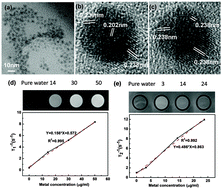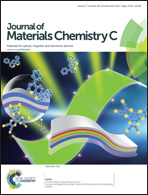Microfluidic synthesis of ultra-small magnetic nanohybrids for enhanced magnetic resonance imaging†
Abstract
We have developed a core alloying and shell gradient doping strategy for the controlled surface modification of nanoparticles, realized by a coupled competitive reducing-nucleation and precipitation reaction controlled in microfluidic channels. Here it is extended in surface modification of Fe and CoFe nanoparticles by doping zinc oxide and aluminum oxide to form well-dispersed stable ultra-small Fe(1−x)Znx@Zn(1−y)FeyO–(OH)z and (CoFe)(1−x)Alx@Al(1−y)(CoFe)yO–(OH)z nanohybrids as contrast agents for magnetic resonance imaging (MRI). They exhibit greatly enhanced T1 weighted spin echo imaging and T2 weighted spin echo imaging effects. Particularly, (CoFe)(1−x)Alx@Al(1−y)(CoFe)yO–(OH)z nanohybrids give a T1 relaxation rate (R1) of 0.156 (μg-CoFe mL−1)−1 s−1 and a T2 relaxation rate (R2) of 0.486 (μg-CoFe mL−1)−1 s−1, much higher than the commercial gadopentetate dimeglumine (R1 = 0.022 (μg-Gd mL−1)−1 s−1; R2 = 0.025 (μg-Gd mL−1)−1 s−1). The R1 of (CoFe)(1−x)Alx@Al(1−y)(CoFe)yO–(OH)z nanohybrids is also higher than superparamagnetic iron oxide (SPIO) nanoparticles (R1 = 0.121 (μg-Fe mL−1)−1 s−1). SPIO nanoparticles of 7.1 ± 1.2 nm still show an excellent negative MRI contrast agent by the highest R2 (5.07 (μg-Fe mL−1)−1 s−1) and R2/R1 ratio (42) among these reagents.


 Please wait while we load your content...
Please wait while we load your content...